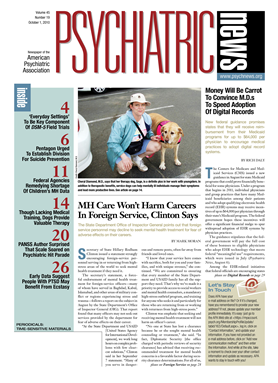The U.S. military services must alter their training, culture, and administrative structure to stem the steadily rising number of suicides in their ranks, according to a new report from a Department of Defense (DoD) task force.
Among the 49 findings and 76 recommendations in the report, mandated last year by Congress, is a call for a suicide-prevention division in the department to “standardize policies and procedures with respect to resiliency, military fitness, life skills, and suicide prevention.”
Training for everyone from recruits to top-level officers should include interpersonal and leadership skills to promote the well-being of troops and reduce the stigma attached to seeking help.
The incidence of suicide has continued to rise among service members despite a plethora of programs and services intended to combat it.
To date, each service branch has developed and carried out its own suicide-prevention programs, which are often overlapping and uncoordinated, according to the report.
The DoD document, issued at the end of August, came barely a month after the U.S. Army tackled suicide prevention in its own 350-page report (Psychiatric News September 3). The Army report emphasized a need for tighter discipline and greater awareness of high-risk behavior by soldiers, along with better access to mental health care.
The two reports offer a “complementary perspective” on the problem, said a psychiatrist who served on the DoD panel.
“We wanted to take a public-health approach to suicide prevention,” said Col. John Bradley, M.C., chief of psychiatry at Walter Reed Army Medical Center and the National Naval Medical Center in Bethesda, Md.
That approach began with the task force looking at what was and wasn't working in military and civilian suicide-prevention models, he said, in an interview.
The new report focused its findings and recommendations on four areas: organization and leadership; wellness enhancement and training; access to and delivery of quality care; and surveillance, investigations, and research.
U.S. military forces have been worn down by frequent deployments separated by insufficient time to recover between the overseas assignments, said the report. “Stress on the force must be reduced.”
That may be a policy issue for the politicians to deal with, but there is an immediate need to develop skills to counter that stress.
“People need to be maximally resilient,” said Bradley. “We need a culture where resilience and help seeking are rewarded, but there are still stigma and bias against help seeking because it identifies a person as having a problem.”
Sometimes even policies intended to protect soldiers with physical or mental health problems can paradoxically keep them from getting treated, he said.
The relatively short “dwell” time at home between deployments means that soldiers may not yet be stabilized and are thus ineligible for their next deployment.
“That blocks their career progression and reduces unit cohesion,” said Bradley.
Officers and noncommissioned officers should be held accountable for “ensuring a positive command climate” to promote overall fitness and encourage service members to seek help when needed.
In addition, the services must expand access to and delivery of evidence-based mental health services that use electronic health records to integrate the work of chaplains, crisis hotline workers, and primary care and mental health clinicians.
Finally, the report called on the Pentagon to integrate research efforts to shed more light on programs.
“DoD does not have an effective standardized approach to suicide surveillance,” said the report. “Because a gold standard has not been established for evaluation, the task force was unable to grade service suicide programs.”
For example, the report's authors urged that suicide investigations should better document the last hours, days, and weeks of those who attempt or commit suicide.
The psychiatric community can help by focusing attention on access to and quality of care for service-related behavioral health problems, said Bradley.
